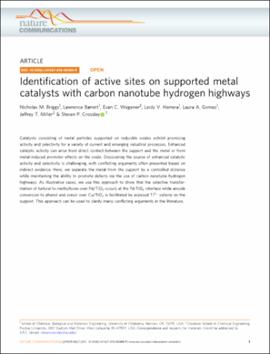| dc.contributor.author | Briggs, Nicholas M. | |
| dc.contributor.author | Barrett, Lawrence | |
| dc.contributor.author | Wegener, Evan C. | |
| dc.contributor.author | Herrera, Leidy V. | |
| dc.contributor.author | Gomez, Laura A. | |
| dc.contributor.author | Miller, Jeffrey T. | |
| dc.contributor.author | Crossley, Steven P. | |
| dc.date.accessioned | 2019-03-29T18:24:28Z | |
| dc.date.available | 2019-03-29T18:24:28Z | |
| dc.date.issued | 2018-09-20 | |
| dc.identifier.citation | Briggs, N. M.; Barrett, L.; Wegener, E. C.; Herrera, L. V.; Gomez, L. A.; Miller, J. T.; Crossley, S. P.Identification of Active Sites on Supported Metal Catalysts with Carbon Nanotube Hydrogen Highways. Nat. Commun.2018, 9, 3827, 10.1038/s41467-018-06100-9 | en_US |
| dc.identifier.uri | https://hdl.handle.net/11244/317823 | |
| dc.description.abstract | Catalysts consisting of metal particles supported on reducible oxides exhibit promising
activity and selectivity for a variety of current and emerging industrial processes. Enhanced
catalytic activity can arise from direct contact between the support and the metal or from
metal-induced promoter effects on the oxide. Discovering the source of enhanced catalytic
activity and selectivity is challenging, with conflicting arguments often presented based on
indirect evidence. Here, we separate the metal from the support by a controlled distance
while maintaining the ability to promote defects via the use of carbon nanotube hydrogen
highways. As illustrative cases, we use this approach to show that the selective transformation
of furfural to methylfuran over Pd/TiO2 occurs at the Pd-TiO2 interface while anisole
conversion to phenol and cresol over Cu/TiO2 is facilitated by exposed Ti3+ cations on the
support. This approach can be used to clarify many conflicting arguments in the literature | en_US |
| dc.description.sponsorship | We acknowledge financial support from the National Science Foundation, Grant CAREER1653935. Use of the Advanced Photon Source is supported by the U.S. Department of Energy, Office of Science, and Office of Basic Energy Sciences, under Contract DE-AC02-06CH11357. MRCAT operations are supported by the Department of Energy and the MRCAT member institutions. E.C.W. and J.T.M. were supported in part by Center for Innovative Transformation of Alkane Resources (CISTAR) by the National Science Foundation under Cooperative Agreement No. EEC-1647722.
Open access fees fees for this article provided whole or in part by OU Libraries Open Access Fund. | en_US |
| dc.language | en | en_US |
| dc.rights | Attribution 4.0 International | * |
| dc.rights.uri | https://creativecommons.org/licenses/by/4.0/ | * |
| dc.subject | Carbon nanotubes and fullerenes | en_US |
| dc.subject | Catalyst synthesis | en_US |
| dc.subject | Chemical engineering | en_US |
| dc.subject | Heterogeneous catalysis | en_US |
| dc.title | Identification of active sites on supported metal catalysts with carbon nanotube hydrogen highways | en_US |
| dc.type | Article | en_US |
| dc.description.peerreview | Yes | en_US |
| dc.identifier.doi | 10.1038/s41467-018-06100-9 | en_US |
| ou.group | Gallogly College of Engineering::School of Chemical, Biological and Materials Engineering | en_US |

